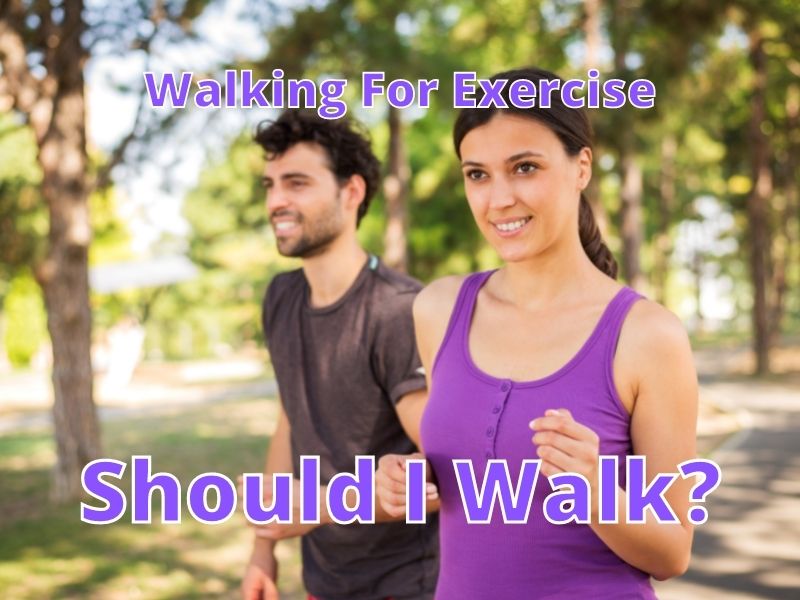I love to walk in the evening. I walk along empty streets with low traffic and can listen to music, a podcast, or talk with a friend. I’ve found it a good way to change my mood. But is it helping me to get exercise?
Walking is a good form of exercise if you get your heart rate elevated. Walking is on par with running for the benefits it can have on your health. Walking for exercise will work if you consistently raise your heart rate during your walk several times a week.
Your body needs to move to stay healthy and walking provides many of the benefits that we can’t get when we are sedentary. Even slow walking will greatly benefit us over the years in providing many health benefits that we will talk more about in this article.
Is Walking a Type of Exercise?
When you walk, you carry your weight. This is called weight-bearing exercise. Walking is a good type of cardio exercise. Cardio is a short form of “cardiovascular,” which refers to the heart (cardio) and blood vessels (vascular) of the body.
Cardio exercise intensifies your heart’s pumping power, allowing oxygen-rich blood to reach all muscles, organs, and tissues in your body more efficiently.
Any activity that makes your heart, lungs, and large muscle groups work harder is aerobic or cardio exercise. And walking does all that.
You may feel that walking is too low-impact to have a significant effect on your body, but that’s not true. Especially when you’re just starting, running or intensive workouts may be too much and too fast for you.
Walking is an effective exercise program to lose weight and improve your overall health if you follow a balanced calorie diet. So you shouldn’t feel you aren’t doing enough. In fact, keeping up with a walking plan may be easier than keeping up with other exercise plans.
In my opinion, walking is an excellent exercise, especially if you suffer from joint pain, an injury, or lower back pain. But remember, to burn your extra calories and enjoy the many benefits of walking, you will need to walk regularly for a long time.
Planning Your Walking Routine

Now that you’re ready to start walking for exercise, the next step is to plan your walking routine.
Where to walk?
I have a few options for you so that poor weather won’t be an issue, and you can prevent boredom and change up the intensity.
- Sidewalks: Walking on the sidewalks is the safest option when you’re in a city or busy area. Keep your eyes on the path ahead and keep yourself alert for people who might move quickly around you.
- School track: I used to go down to the local college track and run on it in the morning. Community member could use it while it was not it use. People also enjoyed walking laps as well.
- Indoor mall: In off-shopping hours, this could be a good option as it offers a temperature-controlled and uniform surface with stairwells to increase the intensity.
- Treadmill: if you have a treadmill, you’re sorted. You can adjust the incline and speed on this machine to increase or decrease intensity. But to make sure you are using the treadmill correctly, always request a demonstration or read the equipment instructions carefully.
- Home exercise videos: If you like to walk to music and follow an instructor, there are various free and for purchase videos available online. Preview the video for the right intensity and tempo before you follow it.
Clothing
You should wear comfortable walking clothes that don’t restrict your movements. I would suggest wearing special sweat-wicking fabrics, like polyester and nylon, to keep moisture away from your skin while you walk. They move sweat to its outer surface to evaporate quickly.
Do not wear cotton clothes as they absorb sweat, add weight and moisture to your body, and don’t dry easily. You can wear layers as your body temperature may change while walking.
Footwear
Generally, any fitness or running shoe is suitable for walking. But make sure your shoes have flexible soles and provide good arch support. During walking, your foot may swell because of extra blood flow, so you would need extra room in the toe bed.
I would suggest buying shoes at least a half size larger than your usual size to avoid the blisters that may develop if your feet rub against the shoe or if your toes rub against each other.
How Fast Should You Walk?
For a moderate-intensity workout, aim for a brisk walking pace. Walking at that level would lead to the greatest health benefits. For moderate intensity, you should be able to walk a mile in about 20 minutes, at a target heart rate of 64% to 76% of your maximum rate. (verywellfit.com)
Your brisk walking should feel like:
- You are breathing heavier than usual
- You do not feel out of breath
- You can still carry on a full conversation while walking
It’s okay if your speed is slower and your heart rate is lower during the initial weeks. Ideally, you need to walk for at least 30 to 60 minutes a day without getting injured. It will be faster and more intense later. Before you attempt to walk faster, be consistent with how often and how far you walk.
If you experience difficulty during your walk, slow down your pace to the starting point. Make sure you know the warning symptoms of heart attacks and strokes and seek medical care if necessary.
How Often Should You Walk?
Although 150 minutes of brisk walking per week is a wonderful goal to aim for, by extending the duration, frequency, and intensity of your walking sessions, you can reap even greater benefits. If you follow this guideline, you should walk for thirty minutes five times a week.
If it sounds challenging to you, I suggest breaking this down into more manageable time chunks like:
- Three 10-minute walks daily
- Two 15-minute walks daily
Health Benefits of Walking

Walking has many physical and mental health benefits:
Physical health benefits of walking
- 1. Walking helps you feel more energetic throughout the day.
- 2. Walking improves your mood during the day.
- 3. You can get your daily dose of physical activity through walking.
- 4. Walking is an excellent exercise for weight loss.
- 5. It helps you prevent or manage your health conditions.
- 6. Walking Strengthens your muscles.
- 7 It enhances your mental clarity.
- 8. Daily walk helps you sleep better at night.
- 9. It helps you in making healthier choices throughout the day.
- 10 Walking improves your immune system.
- 11. It Improves your health and prevents diseases.
- 12. Taking a 30-minute walk daily can lower your risk of heart disease.
- 13. Those with diabetes may also benefit from walking because it lowers blood sugar levels.
- 14. Walking can even help you live a longer and healthier life and reduce your chances of heart disease and certain types of cancer.
Mental health benefits of walking
When it comes to mental health, being active has a multitude of benefits.
- A daily walk helps you focus better throughout the day and improves your mental clarity.
- Walking stimulates your creativity. When you walk, your mind opens up to new ideas, allowing you to solve problems more effectively than if you’re sedentary or seated.
- Walking improves your self-esteem and self-perception.
- Regular walking improves your mood and sleep quality.
- It helps in the reduction of anxiety, stress, and fatigue.
- Walking also lowers the risk of becoming depressed.
- In older people, a regular walking routine helps improve memory, attention, and processing speed, and can lower the risk of cognitive decline and dementia.
- Walking regularly reduces tiredness, which may improve mental alertness.
- Daily walk sharpens your memory and improves your thinking skills.
- You can build resilience and cope with mental and emotional challenges through walking.
The Takeaway
Walking is a great exercise that you can do anywhere and anytime to improve your cardiovascular fitness. But make sure to walk at a pace that challenges your cardiovascular system. The benefits of walking are both physical and mental.
Walking is an inexpensive and effective way to lose weight and gain physical fitness. Perhaps you’re wondering how many calories you can burn through walking. However, there is no one-size-fits-all answer, since your burn depends on several factors, such as your weight, pace, terrain, and more.
To enjoy the many benefits of exercise, you don’t have to spend hours at the gym or take part in monotonous workouts. All you need is a daily walk of 30-minutes and you’ll begin to feel better, look better, and get the most out of life.

